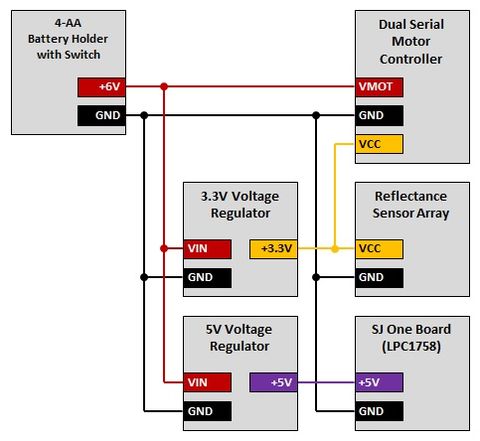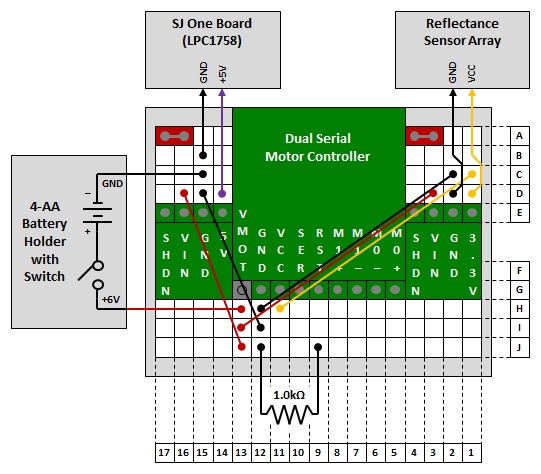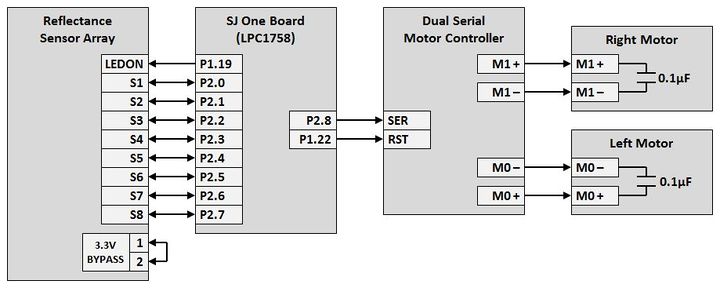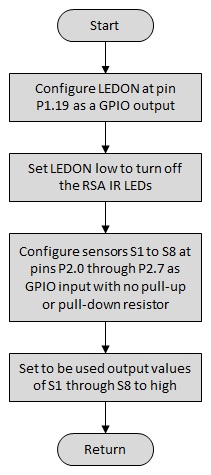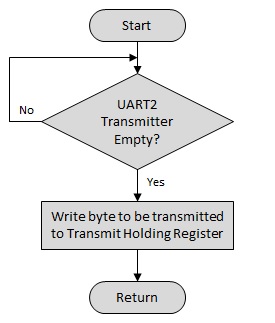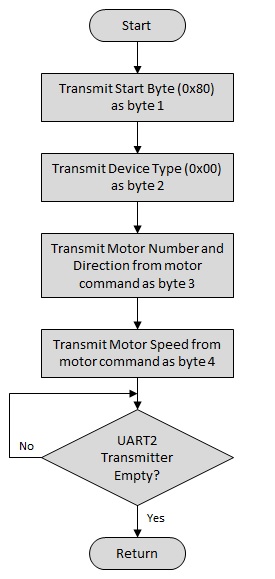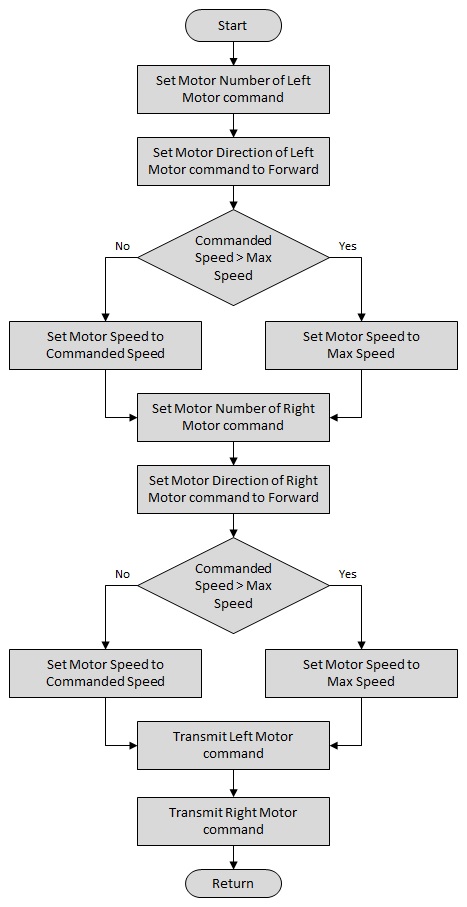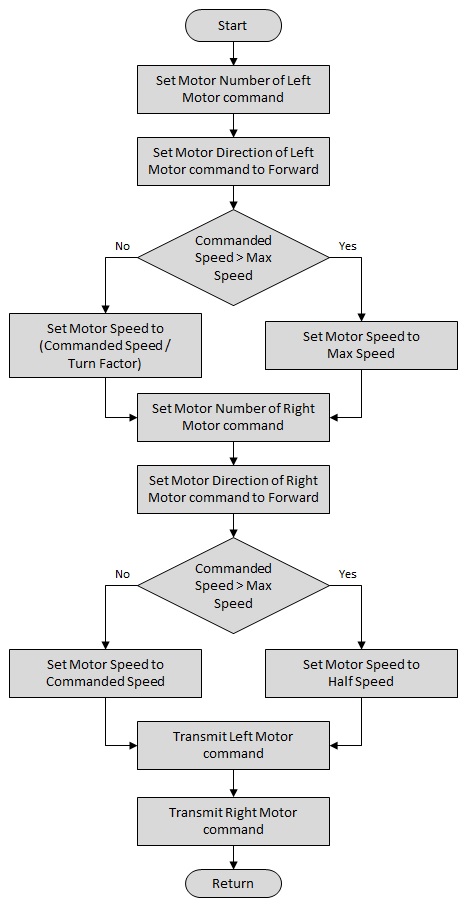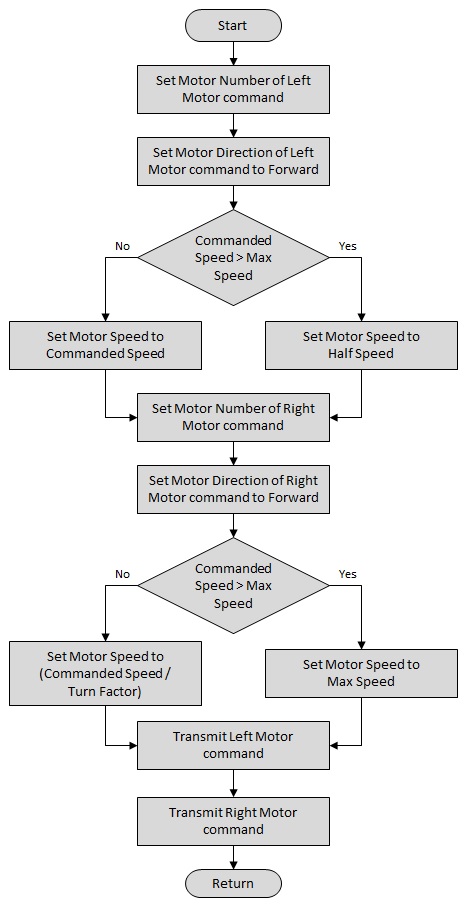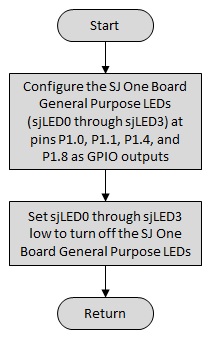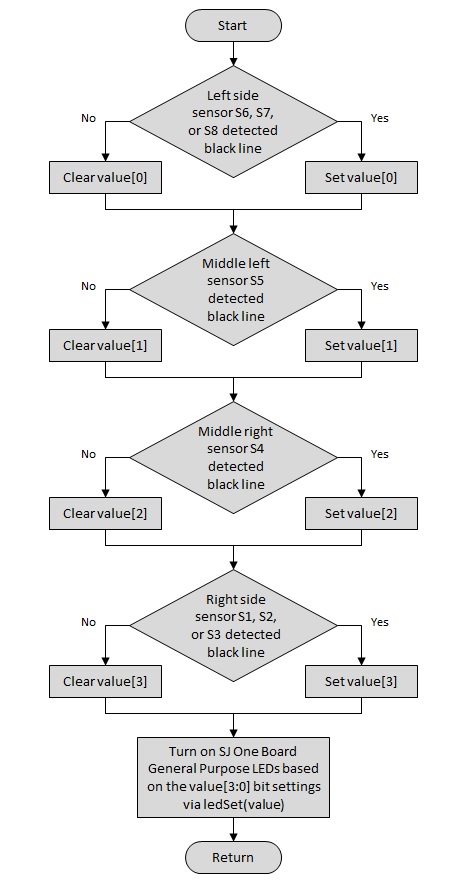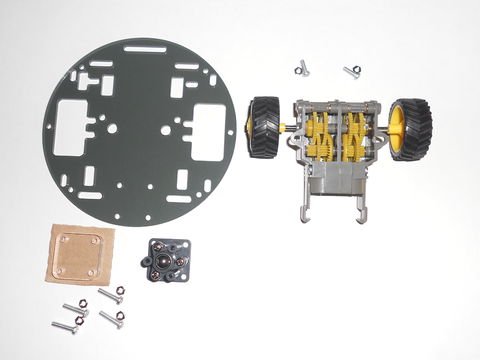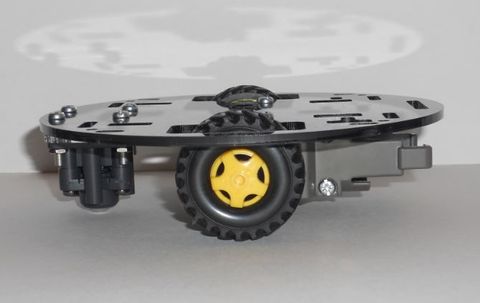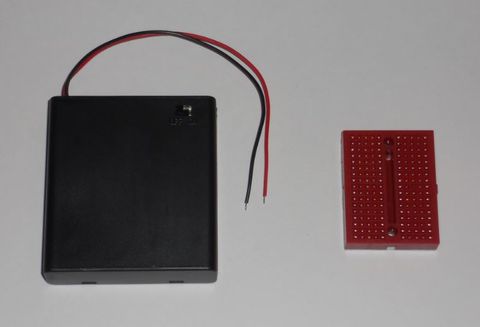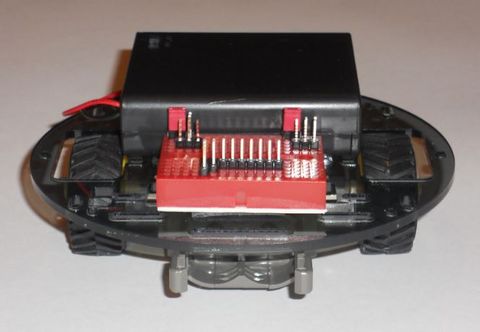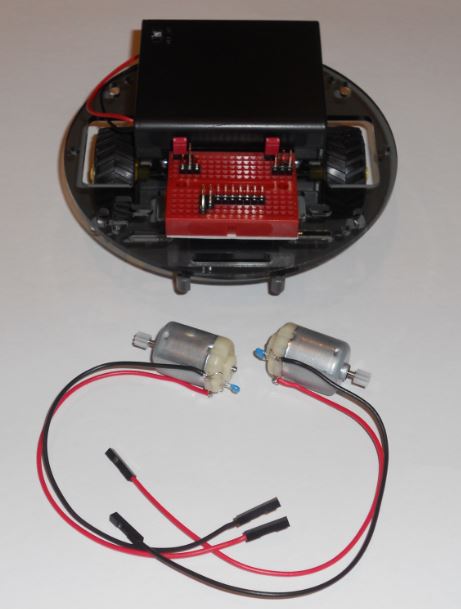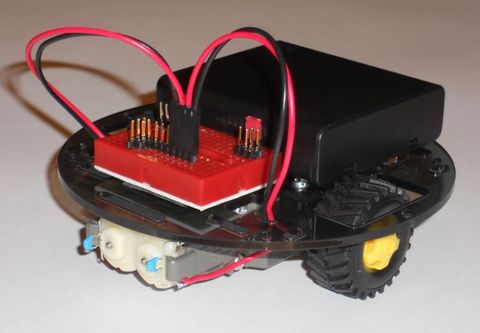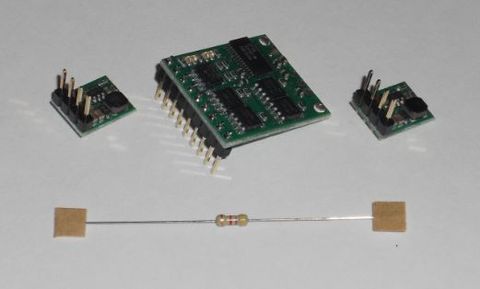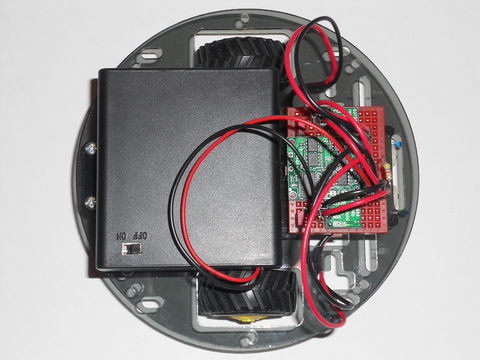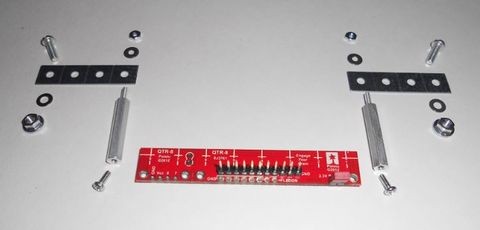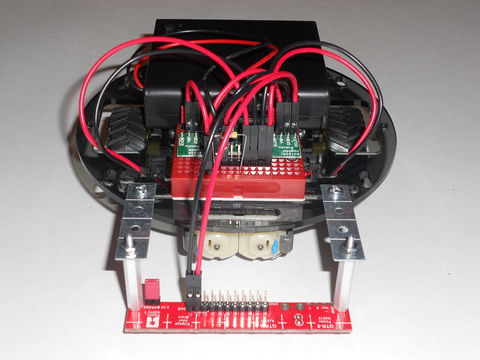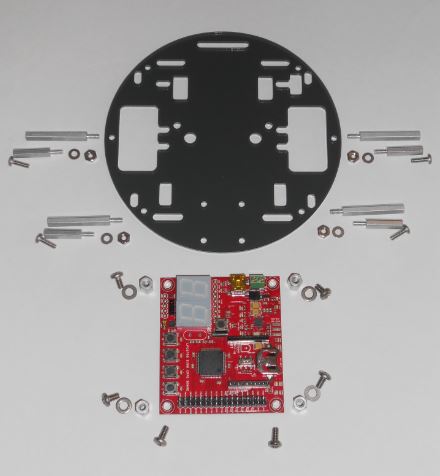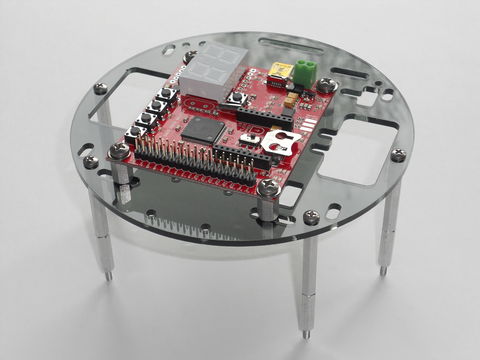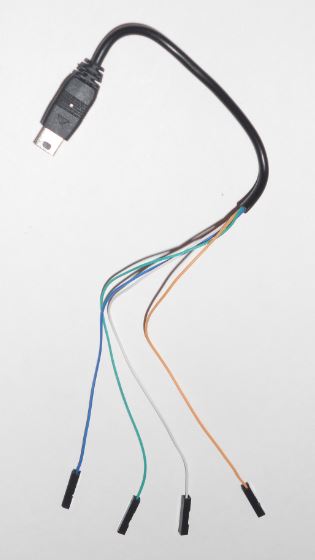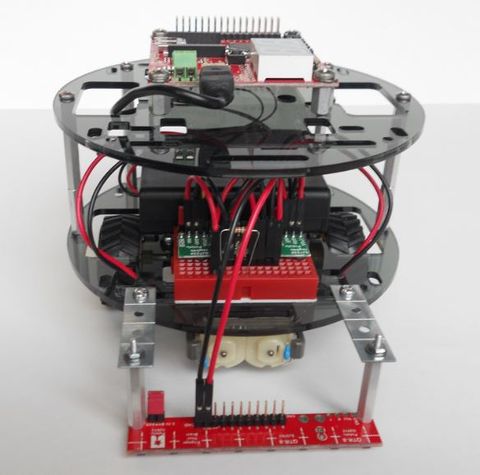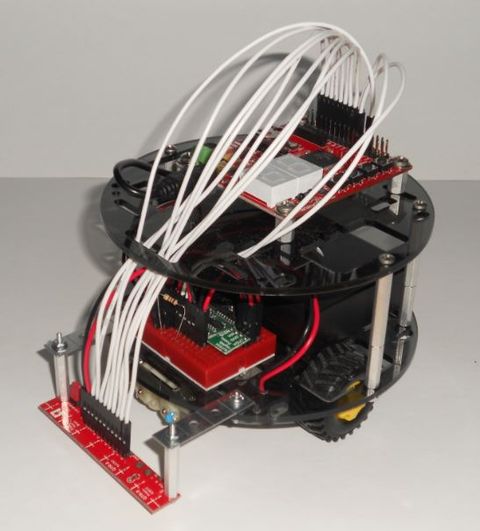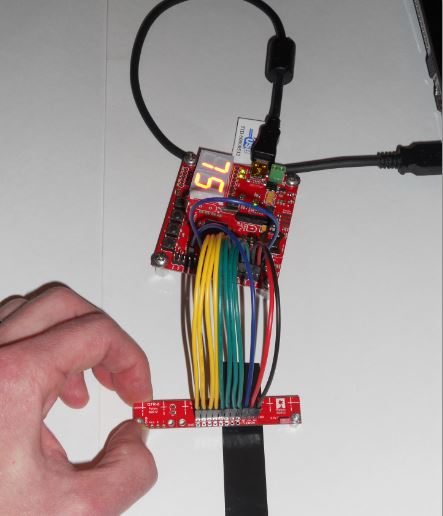Difference between revisions of "F13: Line Following Robot"
Proj user4 (talk | contribs) (→Power Routing) |
Proj user4 (talk | contribs) (→Design & Implementation) |
||
| Line 290: | Line 290: | ||
Other Dual Serial Motor Controller connections depicted by the signal routing diagram include the PWM motor control voltages. The M0+ and M0- outputs are routed to the left motor and the M1+ and M1- outputs are routed to the right motor. As suggested by the Dual Serial Motor Controller User Guide, a 0.1 uF capacitor has been soldered across the two input leads of both motors to reduce the amount of electrical noise generated by the brushed DC motors. | Other Dual Serial Motor Controller connections depicted by the signal routing diagram include the PWM motor control voltages. The M0+ and M0- outputs are routed to the left motor and the M1+ and M1- outputs are routed to the right motor. As suggested by the Dual Serial Motor Controller User Guide, a 0.1 uF capacitor has been soldered across the two input leads of both motors to reduce the amount of electrical noise generated by the brushed DC motors. | ||
| + | |||
| + | === Hardware Interface === | ||
| + | In this section, you can describe how your hardware communicates, such as which BUSes used. You can discuss your driver implementation here, such that the '''Software Design''' section is isolated to talk about high level workings rather than inner working of your project. | ||
{| | {| | ||
| − | [[File: | + | [[File:CmpE240_F13_LFR_rsaInit.jpg|480px|thumb|left|Software Flow Diagram for Reflectance Sensor Array Initialization]] |
|} | |} | ||
{| | {| | ||
| − | [[File: | + | [[File:CmpE240_F13_LFR_rsaRead.jpg|480px|thumb|left|Software Flow Diagram for Reflectance Sensor Array Read]] |
|} | |} | ||
{| | {| | ||
| − | [[File: | + | [[File:CmpE240_F13_LFR_dsmcInit.jpg|480px|thumb|left|Software Flow Diagram for Dual Serial Motor Controller Initialization]] |
|} | |} | ||
{| | {| | ||
| − | [[File: | + | [[File:CmpE240_F13_LFR_dsmcTxByte.jpg|480px|thumb|left|Software Flow Diagram for Dual Serial Motor Controller Transmit Byte]] |
|} | |} | ||
{| | {| | ||
| − | [[File: | + | [[File:CmpE240_F13_LFR_dsmcTxCommand.jpg|480px|thumb|left|Software Flow Diagram for Dual Serial Motor Controller Transmit Command]] |
|} | |} | ||
{| | {| | ||
| − | [[File: | + | [[File:CmpE240_F13_LFR_dsmcStop.jpg|480px|thumb|left|Software Flow Diagram for Dual Serial Motor Controller Stop Command]] |
|} | |} | ||
{| | {| | ||
| − | [[File: | + | [[File:CmpE240_F13_LFR_dsmcMoveForward.jpg|480px|thumb|left|Software Flow Diagram for Dual Serial Motor Controller Move Forward Command]] |
|} | |} | ||
{| | {| | ||
| − | [[File: | + | [[File:CmpE240_F13_LFR_dsmcTurnFwdLeft.jpg|480px|thumb|left|Software Flow Diagram for Dual Serial Motor Controller Turn Forward Left Command]] |
|} | |} | ||
{| | {| | ||
| − | [[File: | + | [[File:CmpE240_F13_LFR_dsmcTurnFwdRight.jpg|480px|thumb|left|Software Flow Diagram for Dual Serial Motor Controller Turn Forward Right Command]] |
|} | |} | ||
{| | {| | ||
| − | [[File: | + | [[File:CmpE240_F13_LFR_ledInit.jpg|480px|thumb|left|Software Flow Diagram for Initialization of SJ One Board General Purpose LEDs]] |
|} | |} | ||
{| | {| | ||
| − | [[File: | + | [[File:CmpE240_F13_LFR_ledSet.jpg|480px|thumb|left|Software Flow Diagram for SJ One Board General Purpose LED Set Control]] |
|} | |} | ||
{| | {| | ||
| − | [[File: | + | [[File:CmpE240_F13_LFR_displayRSA.jpg|480px|thumb|left|Software Flow Diagram for Display of Reflectance Sensor Array Data on the SJ One Board General Purpose LEDs]] |
|} | |} | ||
| + | === Mechanical Design === | ||
{| | {| | ||
| − | [[File: | + | [[File:CmpE240_F13_LFR_2682.jpg|480px|thumb|left|Chassis, Assembled Gearbox with Tires, and Ball Caster]] |
|} | |} | ||
{| | {| | ||
| − | [[File: | + | [[File:CmpE240_F13_LFR_2692.jpg|480px|thumb|left|Assembled Chassis with Gearbox, Tires, and Ball Caster]] |
|} | |} | ||
{| | {| | ||
| − | [[File: | + | [[File:CmpE240_F13_LFR_2698.jpg|480px|thumb|left|Battery Holder (4-AA with Switch) and Breadboard (170-point)]] |
|} | |} | ||
| − | |||
| − | |||
| − | |||
| − | |||
| − | |||
| − | |||
{| | {| | ||
| − | [[File: | + | [[File:CmpE240_F13_LFR_2737.jpg|480px|thumb|left|Assembled Chassis with Battery Holder, Breadboard, Headers, and Jumpers]] |
|} | |} | ||
{| | {| | ||
| − | [[File: | + | [[File:CmpE240_F13_LFR_2746.jpg|480px|thumb|left|Assembled Chassis and Brushed DC Motors with Capacitors and Wires]] |
|} | |} | ||
{| | {| | ||
| − | [[File: | + | [[File:CmpE240_F13_LFR_2753.jpg|480px|thumb|left|Assembled Chassis with Brushed DC Motors]] |
|} | |} | ||
{| | {| | ||
| − | [[File: | + | [[File:CmpE240_F13_LFR_2827.jpg|480px|thumb|left|5V Step-Down Voltage Regulator, Dual Serial Motor Controller, 3.3V Step-Down Voltage Regulator, and Pull-Down Resistor]] |
|} | |} | ||
{| | {| | ||
| − | [[File: | + | [[File:CmpE240_F13_LFR_2834.jpg|480px|thumb|left|Assembled Chassis with 5V Step-Down Voltage Regulator, Dual Serial Motor Controller, 3.3V Step-Down Voltage Regulator, and Pull-Down Resistor]] |
|} | |} | ||
{| | {| | ||
| − | [[File: | + | [[File:CmpE240_F13_LFR_2823.jpg|480px|thumb|left|Reflectance Sensor Array, Universal Metal Joints, 1.0" 2-56 Standoffs, and Hardware]] |
|} | |} | ||
{| | {| | ||
| − | [[File: | + | [[File:CmpE240_F13_LFR_2855.jpg|480px|thumb|left|Assembled Chassis with Reflectance Sensor Array]] |
|} | |} | ||
{| | {| | ||
| − | [[File: | + | [[File:CmpE240_F13_LFR_2875.jpg|480px|thumb|left|Upper Chassis, SJ One Board (LPC1758), 1.25" 4-40 Standoffs, 0.75" 4-40 Standoffs, 0.375" 6-32 Standoffs, and Hardware]] |
|} | |} | ||
{| | {| | ||
| − | [[File: | + | [[File:CmpE240_F13_LFR_2893.jpg|480px|thumb|left|Assembled Upper Chassis with SJ One Board (LPC1758)]] |
|} | |} | ||
{| | {| | ||
| − | [[File: | + | [[File:CmpE240_F13_LFR_2801.jpg|480px|thumb|left|Modified USB Mini-B Cable]] |
|} | |} | ||
{| | {| | ||
| − | [[File: | + | [[File:CmpE240_F13_LFR_2910.jpg|480px|thumb|left|Assembled Chassis and Upper Chassis with Modified USB Mini-B Cable)]] |
|} | |} | ||
{| | {| | ||
| − | [[File: | + | [[File:CmpE240_F13_LFR_2923.jpg|480px|thumb|left|Line Following Robot]] |
|} | |} | ||
| + | |||
| + | === Software Design === | ||
| + | Show your software design. For example, if you are designing an MP3 Player, show the tasks that you are using, and what they are doing at a high level. Do not show the details of the code. For example, do not show exact code, but you may show psuedocode and fragments of code. Keep in mind that you are showing DESIGN of your software, not the inner workings of it. | ||
| + | |||
=== Implementation === | === Implementation === | ||
Revision as of 02:41, 3 December 2013
Contents
Grading Criteria
- How well is Software & Hardware Design described?
- How well can this report be used to reproduce this project?
- Code Quality
- Overall Report Quality:
- Software Block Diagrams
- Hardware Block Diagrams
- Schematic Quality
- Quality of technical challenges and solutions adopted.
Line Following Robot
Abstract
The Line Following Robot detects a black line on a white surface and moves forward following the line. If a black line is not detected, the Line Following Robot moves forward searching for a black line to follow. Once the Line Following Robot detects a black line, it will begin following the black line.
Objectives & Introduction
Objectives
The objectives of the Line Following Robot include:
- Move forward searching for a black line on a white surface.
- Detect a black line on a white surface.
- Generate control commands to follow a detected black line.
Introduction
In order to follow a black line on a white surface, the Line Following Robot interfaces the NXP LPC1758 microcontroller on the SJ One Board with a Reflectance Sensor Array and Dual Serial Motor Controller. The block diagram below illustrates the connectivity of these primary components. The diagram also illustrates the connectivity between the Dual Serial Motor Controller, two brushed DC motors, twin motor gearbox, and two tires.
The LPC1758 microcontroller acquires sensor data from the Reflectance Sensor Array, generates motor commands to steer the Line Following Robot based on the sensor data, and transmits the motor commands via a serial communication interface to the Dual Serial Motor Controller. Upon receipt of the motor commands, the Dual Serial Motor Controller provides the appropriate PWM control signals to the brushed DC motors to steer the Line Following Robot. The process of obtaining sensor data from the Reflectance Sensor Array and transmitting the corresponding motor commands to the Dual Serial Motor Controller repeats at a 20 Hz rate.
Reflectance Sensor Array
The Reflectance Sensor Array includes eight sensors. Each of the eight sensors consists of an IR LED, a phototransistor, and a capacitor connected in series with the phototransistor. To obtain a reflectivity reading from the Reflectance Sensor Array, the microcontroller GPIO pins connected to the sensor I/O pins are driven high to charge the capacitors. Once the capacitors have been fully charged, the microcontroller switches its GPIO pins to inputs. With the microcontroller GPIO pins switched to inputs, the capacitors begin discharging through the phototransistors at a rate based on the reflectivity of the surface illuminated by the IR LEDs. After allowing an appropriate amount of time for the capacitors to discharge accordingly, the eight sensor I/O pins of the Reflectance Sensor Array are read by the microcontroller.
A white surface has a high reflectivity and will turn the phototransistor on. When the phototransistor is turned on, the capacitor in series with it will be allowed to discharge through the phototransistor. With the capacitor discharged, a low voltage will be present at the sensor I/O pin and will be converted as a logical zero by the microcontroller. In contrast, a black surface has a low reflectivity and will not turn the phototransistor on. When the phototransistor is off, the capacitor in series with it will not be allowed to discharge through the phototransistor. As a result, a high voltage will be present at the sensor I/O pin and will be converted as a logical high by the microcontroller. Thus, sensors detecting a white surface will return a logical zero and sensors detecting a black surface will return a logical one when the microcontroller reads the Reflectance Sensor Array.
Sensor Data Analysis
After obtaining a reflectivity reading from the Reflectance Sensor Array, the microcontroller analyzes the data to determine the appropriate motor command to be sent to the Dual Serial Motor Controller. If none of the eight sensors detect a black line, a move forward command is sent to the Dual Serial Motor Controller to continue searching for a black line to follow. A move forward command is also sent to the Dual Serial Motor Controller if either of the two or both of the middle sensors detects a black line. When any of the three sensors on the left side of the Reflectance Sensor Array detect a black line, the Dual Serial Motor Controller is commanded to turn left towards the line. Similarly, if any of the three sensors on the right side of the array detects a black line, a turn right command is sent to the Dual Serial Motor Controller.
Dual Serial Motor Controller
The Dual Serial Motor Controller accepts commands via its serial communication interface using a baud rate between 1200 and 19200 with eight data bits, no parity bit, and one stop bit. Its serial interface is receive-only and automatically detects the baud rate. The UART2 peripheral of the microcontroller is configured to transmit the generated motor commands to the Dual Serial Motor Controller at a baud rate of 9600.
Upon receipt of a motor command, the Dual Serial Motor Controller adjusts its PWM motor control outputs to perform the commanded action. The PWM motor control outputs operate at a frequency of 600 Hz and the voltage level is based on the input motor voltage supplied to the Dual Serial Motor Controller. The PWM motor control outputs provide independent control of two brushed DC motors. The independent control of the two motors allows the Line Following Robot to turn left or right using a ball caster as the third point of balance.
Power
Power for the Line Following Robot is provided by four AA batteries contained in an enclosed battery holder with an included power switch. The four AA batteries generate 6.0 volts which is routed as the motor input voltage to the Dual Serial Motor Controller, the input voltage to the 5.0 V Step-Down Voltage Regulator, and the input voltage to the 3.3 V Step-Down Voltage Regulator. The regulated 5.0 volts is routed to the SJ One Board via a modified USB Mini-B cable. The SJ One Board further regulates the 5.0 volts to 3.3 volts for use by the LPC1758 microcontroller and the other components on the board. The 3.3 V Step-Down Voltage Regulator output is routed to both the Reflectance Sensor Array and the Dual Serial Motor Controller.
Team Members & Responsibilities
- Kurt Breault II
- Hardware Design
- Driver Development
- Software Design
- Integration and Test
- Project Documentation
Schedule
The proposed schedule lists the tasks to be completed each week. The time frame for each task spans from a Wednesday to the following Tuesday. This time frame format was selected to facilitate project progress discussions with the professor at the end of each weekly lecture held on Tuesday.
| Week | Date | Proposed Schedule | Actual Schedule |
|---|---|---|---|
| 1 | 10/02 to 10/08 | Write project proposal. Begin ordering components. |
|
| 2 | 10/09 to 10/15 | Finish ordering components. |
|
| 3 | 10/16 to 10/22 | Generate proposed schedule. Begin mechanical layout of components. Begin electrical layout of componets. |
|
| 4 | 10/23 to 10/29 | Complete mechanical layout of components. Complete electrical layout of components. |
|
| 5 | 10/30 to 11/05 | Interface SJ One Board with IR LED Reflectance Sensor Array. |
|
| 6 | 11/06 to 11/12 | Interface SJ One Board with Dual Serial Motor Controller. |
|
| 7 | 11/13 to 11/19 | Begin integration and test of SJ One Board, IR LED Reflectance Sensor Array, and Dual Serial Motor Controller. |
|
| 8 | 11/20 to 11/26 | Complete integration and test of SJ One Board, IR LED Reflectance Sensor Array, and Dual Serial Motor Controller. |
|
| 9 | 11/27 to 12/03 | Demonstrate project. Write project report. |
|
| 10 | 12/04 to 12/07 | Complete project report. |
|
Parts List & Cost
The table below summarizes the parts used and the cost for the Line Following Robot project.
| Qty | Item Description | Manufacturer | Manufacturer Item No. | Vendor | Vendor Item No. | Cost | Total Cost |
|---|---|---|---|---|---|---|---|
| 1 | SJ One Board (LPC1758) | SJSU | N/A | SJSU | N/A | $75.00 | $75.00 |
| 1 | QTR-8RC Reflectance Sensor Array | Pololu | 961 | Pololu | 961 | $9.95 | $9.95 |
| 1 | Pololu Low-Voltage Dual Serial Motor Controller | Pololu | 120 | Pololu | 120 | $39.95 | $39.95 |
| 1 | Pololu 3.3V, 600mA Step-Down Voltage Regulator D24V6F3 | Pololu | 2106 | Pololu | 2106 | $5.95 | $5.95 |
| 1 | Pololu 5V, 600mA Step-Down Voltage Regulator D24V6F5 | Pololu | 2107 | Pololu | 2107 | $5.95 | $5.95 |
| 2 | Pololu Robot Chassis RRC01A Transparent Gray | Pololu | 250 | Pololu | 250 | $5.95 | $11.90 |
| 1 | Tamiya 70097 Twin-Motor Gearbox Kit | Tamiya | 70097 | Pololu | 61 | $12.00 | $12.00 |
| 1 | Tamiya 70144 Ball Caster Kit (2 casters) | Tamiya | 70144 | Pololu | 66 | $5.99 | $5.99 |
| 1 | Tamiya 70101 Truck Tire Set (4 tires) | Tamiya | 70101 | Pololu | 65 | $4.80 | $4.80 |
| 1 | 4-AA Battery Holder, Enclosed with Switch | N/A | N/A | Pololu | 1159 | $1.75 | $1.75 |
| 4 | AA Alkaline Battery | Panasonic - BSG | LR6XWA/B | Digi-Key | P646-ND | $0.35 | $1.40 |
| 1 | 170-Point Breadboard (Red) | N/A | N/A | Pololu | 1491 | $2.95 | $2.95 |
| 1 | USB Cable A to Mini-B, 6 ft | N/A | N/A | Pololu | 130 | $2.49 | $2.49 |
| 1 | 0.100" (2.54 mm) Breakaway Male Header: 1x40-Pin, Straight, Double-Sided | N/A | N/A | Pololu | 1065 | $1.49 | $1.49 |
| 3 | 0.100" (2.54 mm) Shorting Block: Red, Top Closed | N/A | N/A | Pololu | 971 | $0.19 | $0.57 |
| 1 | Ceramic Capacitor 6-Pack 0.1uF 50V | N/A | N/A | Pololu | 1165 | $0.99 | $0.99 |
| 1 | Stranded Wire: Black, 22 AWG, 50 Feet | N/A | N/A | Pololu | 2640 | $5.00 | $5.00 |
| 1 | Stranded Wire: Red, 22 AWG, 50 Feet | N/A | N/A | Pololu | 2642 | $5.00 | $5.00 |
| 1 | Stranded Wire: White, 22 AWG, 50 Feet | N/A | N/A | Pololu | 2649 | $5.00 | $5.00 |
| 1 | Female Crimp Pins for 0.1" Housings 100-Pack | N/A | N/A | Pololu | 1930 | $5.95 | $5.95 |
| 2 | 0.1" (2.54mm) Crimp Connector Housing: 1x1-Pin 25-Pack | N/A | N/A | Pololu | 1900 | $0.59 | $1.18 |
| 1 | Resistor Kit - 1/4W (500 total) | N/A | N/A | SparkFun | COM-10969 | $7.95 | $7.95 |
| 1 | 0.100" (2.54 mm) Breakaway Male Header: 1x40-Pin, Straight | N/A | N/A | Pololu | 965 | $0.99 | $0.99 |
| 1 | Aluminum Standoff: 1" Length, 2-56 Thread, M-F (4-Pack) | N/A | N/A | Pololu | 1944 | $1.59 | $1.59 |
| 1 | Machine Screw: #2-56, 1/4" Length, Phillips (25-pack) | N/A | N/A | Pololu | 1955 | $0.59 | $0.59 |
| 1 | Machine Hex Nut: #2-56 (25-pack) | N/A | N/A | Pololu | 1067 | $0.99 | $0.99 |
| 1 | Machine Washer: #2 (100-pack) | B&F Fastener Supply | FWSS 002 | Digi-Key | H733-ND | $3.36 | $3.36 |
| 1 | Machine Washer: #4 (100-pack) | B&F Fastener Supply | FWSS 004 | Digi-Key | H734-ND | $3.48 | $3.48 |
| 1 | Tamiya 70164 Universal Metal Joint Parts (4pcs) | Tamiya | 70164 | Pololu | 90 | $3.90 | $3.90 |
| 1 | Aluminum Standoff: 1-1/4" Length, 4-40 Thread, M-F (4-Pack) | N/A | N/A | Pololu | 1951 | $1.99 | $1.99 |
| 1 | Aluminum Standoff: 3/4" Length, 4-40 Thread, M-F (4-Pack) | N/A | N/A | Pololu | 1949 | $1.59 | $1.59 |
| 1 | Machine Hex Nut: #4-40 (25-pack) | N/A | N/A | Pololu | 1068 | $0.99 | $0.99 |
| 1 | Machine Screw: #4-40, 5/16" Length, Phillips (25-pack) | N/A | N/A | Pololu | 1961 | $0.69 | $0.69 |
| 4 | Aluminum Standoff: 3/8" Length, 6-32 Thread, F-F | Keystone Electronics | 2209 | Digi-Key | 2209K-ND | $0.40 | $1.60 |
| 1 | Machine Washer: #6 (100-pack) | B&F Fastener Supply | FWSS 006 | Digi-Key | H735-ND | $3.66 | $3.66 |
| 1 | Machine Screw: #6-32, 1/4" Length, Phillips (100-pack) | B&F Fastener Supply | PMSSS 632 0025 PH | Digi-Key | H708-ND | $6.54 | $6.54 |
| 1 | Machine Screw: #6-32, 3/8" Length, Phillips (100-pack) | B&F Fastener Supply | PMSSS 632 0038 PH | Digi-Key | H710-ND | $8.10 | $8.10 |
| 1 | Scotch Removable Mounting Squares, 1" x 1", 16 ct. | Scotch | N/A | Amazon | N/A | $7.99 | $7.99 |
| 1 | Crimping Tool: 0.1-1.0 mm² Capacity, 16-28 AWG | N/A | N/A | Pololu | 1928 | $34.95 | $34.95 |
| 1 | ST-1 Mini Diagonal Cutter | N/A | N/A | Pololu | 159 | $3.99 | $3.99 |
| 1 | ST-2 Mini Long-Nose Pliers | N/A | N/A | Pololu | 150 | $3.99 | $3.99 |
| 1 | Paladin Tools 1118 GripP 20 Wire Stripper/Cutter, 30-20 AWG | Greenlee Communications | PA1118 | Digi-Key | PA1118-ND | $17.33 | $17.33 |
| Total Cost | $321.52 |
Design & Implementation
The design section can go over your hardware and software design. Organize this section using sub-sections that go over your design and implementation.
Hardware Design
The hardware design of the Line Following Robot is separately described in terms of routing power and signals. The routing of power and signals is considered separately to simplify their description and associated diagrams.
Power Routing
Power for the Line Following Robot is provided by four AA batteries. The four AA batteries are installed in an enclosed battery holder that includes a power switch. The power switch on the enclosed battery holder is used to power the Line Following Robot on and off. When the power switch is set to the on position, the four AA batteries provide +6.0 V.
The +6.0 V provided by the four AA batteries is routed to the VMOT input of the Dual Serial Motor Controller. The VMOT input of the Dual Serial Motor Controller provides the raw motor voltage used to control the brushed DC motors via its PWM motor control outputs. The +6.0 V provided by the four AA batteries is also routed to the VIN inputs of the 3.3V Step-Down Voltage Regulator and 5V Step-Down Voltage Regulator. These connections and the other power routing connections of the Line Following Robot are illustrated in the figure below.
The 3.3V output of the 3.3V Step-Down Voltage Regulator is routed to VCC inputs of the Reflectance Sensor Array and the Dual Serial Motor Controller to provide the logic voltage for these devices. The 5V output of the 5V Step-Down Voltage Regulator is routed to the +5V input of the USB Mini-B connector on the SJ One Board via a modified USB Mini-B Cable. The SJ One Board routes the 5V input voltage to its own internal voltage regulator to supply 3.3V to the on-board LPC1758 microcontroller and other on-board devices. Although the SJ One Board provides its internally generated 3.3V as an output for peripherals, the SJ One Board 3.3V output could not be used due to the current draw on the 5V Step-Down Voltage Regulator and its associated dropout voltage.
The distribution of power for the Line Following Robot is accomplished via the breadboard power routing connections illustrated in the figure below. In addition to the previously described routing of power, both the 3.3V Step-Down Voltage Regulator and 5V Step-Down Voltage Regulator require their active-low SHDN inputs to be tied to their 3.3V and 5V outputs, respectively. These connections are made on the 170-point breadboard via shorting blocks, a.k.a. jumpers, as depicted by the red rectangles in the breadboard power routing connections diagram.
The 1.0 kOhm pull-down resistor for the active-low RST input of the Dual Serial Motor Controller is also illustrated in the breadboard power routing connections diagram. The pull-down resistor is required in the event the microcontroller itself is reset. When the microcontroller is reset, its pins are switched to inputs and no longer provide the intended control for the Dual Serial Motor Controller. The pull-down resistor overrides the floating input condition and asserts reset to the Dual Serial Motor Controller to ensure the motors do not keep running while the microcontroller is recovering from reset.
Finally, the breadboard power routing connections diagram provides the installation location of the Dual Serial Motor Controller, 3.3V Step-Down Voltage Regulator, and 5V Step-Down Voltage Regulator on the 170-point breadboard. Straight male header connectors of the appropriate length are soldered onto each of these components and used to install them on the breadboard. The three components have been drawn to scale relative to the breadboard to provide an indication of the area they consume.
Signal Routing
The Spare I/O pins of the SJ One Board are used to interface the LPC1758 microcontroller with the Reflectance Sensor Array and the Dual Serial Motor Controller. As shown in the figure below, pin P1.19 is configured as a GPIO output connected to the LEDON input of the Reflectance Sensor Array. The LEDON signal is used to turn on the eight IR LEDs while performing a reflectivity reading and to turn them off after obtaining the reading. Turning the IR LEDs off between reflectivity readings conserves power when they are not in use. The P2.0 through P2.7 pins are used as GPIO inputs and outputs. These pins are routed to the eight sensor ports of the Reflectance Sensor Array. When configured as an output, they are driven high to charge the capacitors associated with each of the eight IR LED and phototransistor pairs. When configured as an input, they are read to obtain the reflectivity reading based on the surface illuminated by the IR LEDs.
The remaining connection for the Reflectance Sensor Array does not involve the LPC1758 microcontroller. In order to operate the Reflectance Sensor Array using a 3.3V logic voltage, the two 3.3V bypass pins are connected together using a jumper installed across the male header pins. This connection is required to bypass the second stage of current limiting resistors required to operate the IR LEDs when Reflectance Sensor Array is interfaced with components operating at a 5V logic voltage. With the second stage of current limiting resistors bypassed for 3.3V operation, a sufficient amount of current flows through the IR LEDs to turn them on when the LEDON input is driven high.
The SER input of the Dual Serial Motor Controller is connected to pin P2.8. Pin P2.8 is configured as the TXD2 output of the LPC1758 UART2 peripheral and is used to transmit the motor commands. The RST input of the Dual Serial Motor Controller is connected to pin P1.22. Pin P1.22 is configured as a GPIO output to provide the active-low reset for the Dual Serial Motor Controller during initialization of the Line Following Robot.
Other Dual Serial Motor Controller connections depicted by the signal routing diagram include the PWM motor control voltages. The M0+ and M0- outputs are routed to the left motor and the M1+ and M1- outputs are routed to the right motor. As suggested by the Dual Serial Motor Controller User Guide, a 0.1 uF capacitor has been soldered across the two input leads of both motors to reduce the amount of electrical noise generated by the brushed DC motors.
Hardware Interface
In this section, you can describe how your hardware communicates, such as which BUSes used. You can discuss your driver implementation here, such that the Software Design section is isolated to talk about high level workings rather than inner working of your project.
Mechanical Design
Software Design
Show your software design. For example, if you are designing an MP3 Player, show the tasks that you are using, and what they are doing at a high level. Do not show the details of the code. For example, do not show exact code, but you may show psuedocode and fragments of code. Keep in mind that you are showing DESIGN of your software, not the inner workings of it.
Implementation
This section includes implementation, but again, not the details, just the high level. For example, you can list the steps it takes to communicate over a sensor, or the steps needed to write a page of memory onto SPI Flash. You can include sub-sections for each of your component implementation.
Testing & Technical Challenges
Describe the challenges of your project. What advise would you give yourself or someone else if your project can be started from scratch again? Make a smooth transition to testing section and described what it took to test your project.
Include sub-sections that list out a problem and solution, such as:
Wifi Connection Issues
Many wifi connection issues were encountered. To solve this problem, a dedicated task was created to re-connect to wifi if the connection was ever lost.
Conclusion
Conclude your project here. You can recap your testing and problems. You should address the "so what" part here to indicate what you ultimately learnt from this project. How has this project increased your knowledge?
Project Video
Upload a video of your project and post the link here.
Project Source Code
Send me your zipped source code and I will upload this to SourceForge and link it for you.
References
Acknowledgement
Any acknowledgement that you may wish to provide can be included here.
References Used
List any references used in project.
QTR-8A and QTR-8RC Reflectance Sensor Array User’s Guide
Low-voltage Dual Serial Motor Controller User’s Guide
Pololu 5V, 600mA Step-Down Voltage Regulator D24V6F5 Description
Pololu 3.3V, 600mA Step-Down Voltage Regulator D24V6F3 Description
Pololu Round Robot Chassis RRC01A User’s Guide
Video Tutorial for Crimping PCB Interconnect Cables
Appendix
You can list the references you used.

